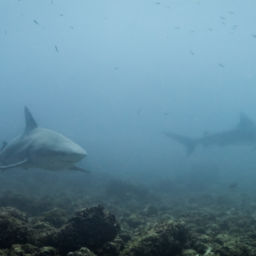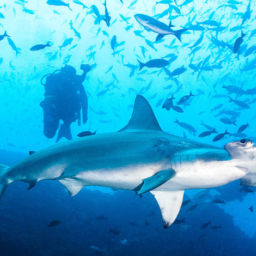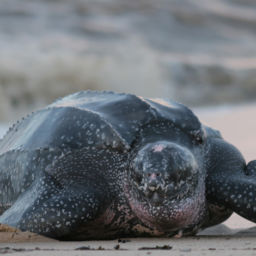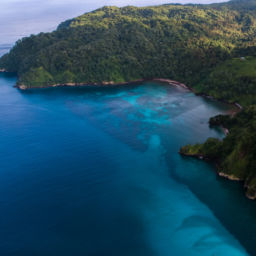Some places have reached near-mythical status in the dive community: Cocos Island, Costa Rica is one of them. Cocos has been on the western world’s radar since at least the 1500s and is the reputed burial place for at least three different hauls of treasure. “These days, of course, divers know where the real treasure is at Cocos Island,” says Avi Klapfer, one of the Undersea Hunter owners, and coauthor of “Costa Rica Blue.” “It’s under the water, and we find it every time we come here.”
Klapfer and Undersea Hunter co-owner Yosy Naaman began exploring these waters in 1990, sailing around the island with sonar, seeking out the spots where the sharks congregated for a cleaning. They’d find such a spot, throw in an anchor and descend using the anchor line, often in raging currents, to look around. They began running dive trips here shortly thereafter on the Undersea Hunter, and added the Sea Hunter and Argo to their fleet in later years. And although diving protocol is far more organized now on Cocos than it was in the early days, make no mistake — the diving can still be wild.
Diving Cocos Island has been atop my bucket list for years and now I’m finally onboard the Sea Hunter, on my way to find out if Cousteau’s assessment of the island holds up (spoiler alert: it does).
Getting to Cocos Island
Part of Cocos’ allure lies in its location, completely isolated and uninhabited, save for a handful of park rangers who rotate on a month-on-month-off basis, hundreds of miles off the Costa Rican coast — to get to Cocos, you’ve got to really want it. I fly first into San Jose, Costa Rica’s capital, where I spend the night before a pick-up the next morning. Sea Hunter collects guests at several area hotels before we’re on our way via shuttle bus to Puntarenas, a little under two hours away.
There are 18 guests onboard for our week-long trip, although the Sea Hunter can accommodate 20. Everyone on the bus is giddy with the same excitement I’m feeling. A few are return guests, unable to get enough of this fabled island no matter how many times they visit. After a stop for lunch, we arrive in Puntarenas where the real bulk of our journey begins: from here, Cocos is a 36-hour sail each way.
The first order of business as we’re steaming away is an in-depth safety briefing. Cocos is home to some notorious currents, and dives are deep here, maxing out at around 120 feet (36m). In a place where a current can sweep you away in an instant, Sea Hunter takes safety very seriously. Everyone gets a clip-on safety kit for their BCD, free of charge. In one bag is a Nautilus Lifeline and in the other is a giant SMB, a whistle, and a dive light to shine in the SMB. My nerves, which have been anxiously anticipating the currents for weeks, feel somewhat soothed.
After the briefing, I meet my roommate and dive buddy Lena from Norway, who’s here on her second visit, and chat with the other guests who hail from around the globe. Now it’s just a waiting game, and we all lounge about the salon, willing the time to pass.
Aboard the Sea Hunter
On the steam out to Cocos, I’ve got plenty of time to check out the boat. The Undersea Hunter Group bought the Sea Hunter in 1994 and completed extensive renovations. The roomy 115-foot (31 m) boat feels like a comfortable family room — inviting, lived-in and thoroughly loved. It features 10 cabins, each with a private bathroom. Lena’s and mine is in the stern, with plenty of floor space, storage and colorful hammerhead murals on the wall. There’s plenty of storage on the dive deck as well, with each guest receiving an assigned berth for their gear. The bench opens up to reveal even more bin space underneath for extra masks, fins, lights and more.
Inside, the roomy salon leads to the dining room and kitchen, where meals appear buffet style. Just as with any other liveaboard, the food can make or break the trip. After the first meal, I’m happy to report that chef Luis and his assistants Javier and Paka seem more than up to the task of keeping us fed and happy over the course of the week. The rest of the crew — 10 in total, including three divemasters on this trip — is warm, welcoming, and utterly professional as well.
Diving at Cocos Island
After leaving Puntarenas around 4 pm, we arrive in Cocos before dawn two days later — just shy of 36 hours, as we’ve had a lucky, smooth sail. The impossibly green island shimmers in the early morning sunlight, ringed in a light mist. Waterfalls cascade down cliff faces and I feel like I’ve just arrived on set of “Jurassic Park.”
We anchor in Chatham Bay, where we’ll do our checkout dive. There are only two anchorages on Cocos, and we’ll spend most of the week at this one, diving from a panga (the local word for skiff). The Sea Hunter has two pangas, but they’re so nice they’d each qualify as a day boat anywhere else. Our group of 18 splits into two, so we’ll dive with the same people all week. There are three dives a day, two in the morning and one in the afternoon, and groups trade off sites, so it’s never crowded underwater. Undersea Hunter’s other boat, the Argo, is already here when we arrive, so we coordinate with them as well to make sure no two groups are at the same site at the same time.
After an uneventful checkout dive, it’s time for our first marquee dive: Manuelita Island, a small, rocky outcropping just off the main island. There are actually three sites here: Manuelita Coral Garden, Manuelita Outside and the Manuelita Channel. We dive first at Manuelita Coral Garden, dropping down into scattered coral heads and boulders to around 75 feet. There’s no current to speak of, so we swim over to a cleaning station and wait for the action to begin. With a curious hammerhead coming in close for a look and two tiger sharks swimming in the near distance, we don’t need to wait for long. Our third dive of the day starts in Manuelita Channel, where we again spot some hammers before heading into the garden to poke around.
Each day unfolds in a similar manner: breakfast, followed by two dives, followed by lunch, a dive, a nap (not mandatory, but highly recommended) and dinner. On day two, we visit Dirty Rock, thusly named because it sticks just a little bit out of the water and is covered in bird droppings. We head down to about 110 feet in a moderate current and again wait to see what the cleaning station will deliver. Vis isn’t great, but no one complains when a small school of hammerheads appears nearby. The next day promises even more excitement at Alcyone, Cocos’ most famed site.
Bajo Alcyone
Discovered by Jacques Cousteau and crew and named for his expedition ship Alcyone, this site is one of the world’s most famous — both for bountiful marine life and copious current. Dive entries here must unfold precisely: there’s a mooring line attached to the top of the seamount, which sits at about 90 feet (30 m). The panga attaches first to that, and then extends a trail line from the mooring line along the side of our boat. We enter the water one at a time, with the trail line in hand, to pull ourselves in the current along the surface. Once we reach the mooring line, we descend on that, hand-over-hand, until we reach the top of the seamount. Once the entire group has arrived, we spread out a bit, tucking into boulders and hiding behind rocks from the sweeping current.
Our first dive here goes off without a hitch. Though the current is insistent, it’s by no means unmanageable, and divers free-swim over to the mooring line to descend. Once we settle in at about 100 feet (30 m), we look up and out as a tornado of jacks swirls by and a small school of hammerheads holds its place, undulating in the current.
Our second dive the next day is a bit more eventful, as we each backroll one at a time, tow line in hand, into a screaming current. I’m the second-to-last to jump, and as I attempt to pull myself along, I doubt that I’ve got the strength to even reach the mooring line.
The current is so strong that I can’t even turn my head to tell the divemaster I’m struggling for fear that it will rip the mask off my face and regulator out of my mouth. But I don’t have to fret for long: the line suddenly goes slack in my hand. The weight of the divers on the line, combined with the strength of the water, snaps the mooring line clean off the seamount at the base and soon we’re all drifting along together in about 20 feet (6 m) of water before we converge on the surface.
After repairing the line the next morning, I’m about to discover that the third time’s the charm at Alcyone. We descend again, following the same protocol. The current is strong, but nothing like yesterday’s. A few minutes into the dive we look up and see the outline of a whale shark, surrounded by schooling jacks, slowly moving across the seamount in about 80 feet of water. We’re thrilled and follow its progress with our eyes before we hear the signal to let go and drift into the blue as we slowly ascend.
But the best is yet to come — as we drift along in about 40 feet (12 m) of water, the curious whale shark, a juvenile, appears from the blue to join us. It circles and circles our group, coming closer and closer to take a good look. The shark spends at least 20 minutes with us, and the experience easily makes it onto my mental list of top 10 dives.
The grand finale
Diving here, I come to realize, is like listening to your favorite songs from your favorite albums on repeat. We visit the three greatest hits: Alcyone, Dirty Rock and Manuelita — multiple times during the week. But they never grow stale — on the contrary, there’s always something to see. On one of our last dives at Manuelita Outside, we’re tucked in among the rocks as usual, watching and waiting.
Suddenly the mood changes; the fish disappear and there’s almost a feeling of electricity in the water. From the haze on the left, we spot a lone, large shark, cruising ever-so-slowly toward us. It’s one of the island’s infamous tiger sharks, which began appearing regularly in these waters around 2008. Its power and magnificence are undeniable as it undulates slowly by us, clearly aware of us but utterly nonplussed by our presence. I duck down a little further in the coral (I’m a chicken, remember), but feel lucky we’ve had such a close encounter with such a magnificent animal.
Everyone is giddy when we hit the panga. After our whale-shark sighting, countless hammerheads and other sharks, and now a close-up swim-by from a tiger shark, we’re all feeling like the island gave us one last gift before we depart. Maybe those divers who visit Cocos over and over are onto something, I silently decide. But I’ll have plenty of time to think about another visit on the 36-hour boat ride home.
Make it happen
Lots of divers have lots of questions about Cocos — I know I did before visiting. To address them, we’ve compiled a handy Q&A that you’ll find here.
Other than the time commitment on board the boat, however, getting to Cocos Island is relatively straightforward. You’ll fly into San Jose — make sure to choose one of the Undersea Hunter partner hotels for easy pickup in the morning — and then take a bus, two hours to the port at Puntarenas the next day. From there it can take up to 36 hours — though often less, depending on conditions — to get out to the island. Undersea Hunter runs 10- and 11-day trips, with seven days of diving. Nitrox fills are included, and you’ll definitely want to take advantage of them, so make sure you’re certified before the trip.





















